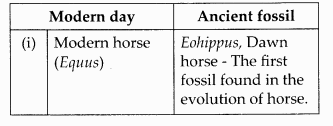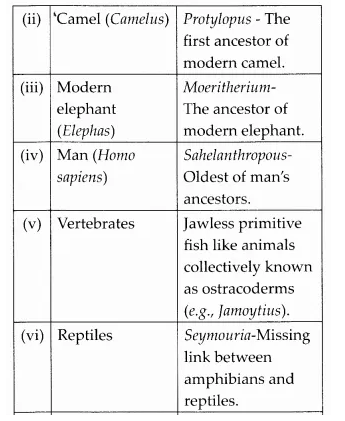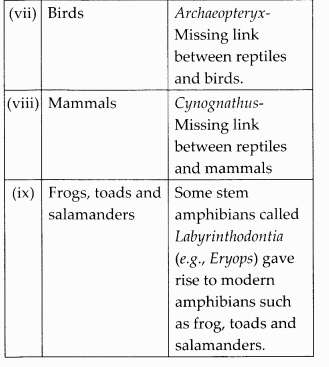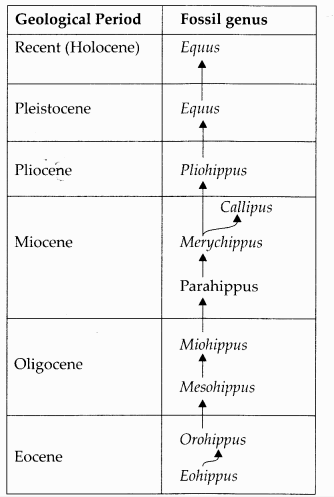NCERT Solutions for Class-12 Biology Chapter-7 Evolution
NCERT EXERCISE
Question 1. Explain antibiotic resistance observed in bacteria in light of Darwinian selection theory.
Solution: Penicillin when discovered was used as an antibiotic against all bacteria. Soon many of these became resistant. This is because alleles of resistance which are already present in bacteria are of no importance in absence of antibiotics. Adjustment to change in environment due to genetic variation is adaptation.
Solution:
Chimps are more evolved than humans (The Times of India): Chimpanzees are more evolved than humans, a study suggests. There is no doubt that humans are the more advanced species. But a comparison of 14,000 human and chimpanzee genes shows the forces of natural selection have and the greatest impact on our ape cousins.
The researchers’ discovery challenges the common assumption that our large brains and high intelligence were the gifts of natural selection. Humans and chimps followed different evolutionary paths from a common ape ancestor about 5 million years ago. Both underwent changes as the fittest survived to pass their genes on to future generations. But the US study shows that humans possess a ‘substantially smaller’ number of positively-selected genes than chimps.
Question 3. Attempt giving a clear definition of the term species.
Solution: A species generally includes a similar organism. Members of this group can show interbreeding. A similar group of genes are found in the members of the same species and this group has the capacity to produce new species. Every species has some cause of isolation which interrupted the interbreeding with the nearest reactional species which is referred to as reproductively isolated.
Question 4. Try to trace the various components of human evolution (hint: brain size and function, skeletal structure, dietary preference, etc.)
Solution: Human evolution shows the following trends,
(i) Brain size: It increased gradually along with evolution. The brain capacity of Australopithecus africanus – 500 cc, Homo habilis – 700 cc, Homo eredus – 800 – 1300 cc, Homo sapiens sapiens – 1450 cc.
(ii) Skeletal structure:
- Dryopithecus was ape-like, without brow ridges, had semierect posture, and prognathous face (having a projecting jaw).
- Ramapithecus had jaws and teeth like humans (small canines and large molars), prognathous face, and walked on legs
- Australopithecus africanus had erect posture, human-like teeth, was without chin, with brow ridges, and had a prognathous face.
- Homo habilis walked nearly erect, had human-like teeth, with brow ridges face was slightly prognathous.
- Homo erectus had an erect posture, prognathous face, with projecting brow ridges, small canines, and large molar teeth and had a small chin.
- Homo sapiens had four curves in the vertebral column, orthognathous face (without projecting jaw), forehead broad, chin well developed, walked on the sole.
(iii) Dietary preference: Dryopithecus and Ram-apithecus were herbivores, Australopithecus africanus and Homo habilis were carnivores, Homo erectus and Homo sapiens were omnivores.
Question 5. Find out through the internet and popular science articles whether animals other than man have self-consciousness.
Solution: There are many animals other than humans, which have self-consciousness. An example of an animal being self-conscious is dolphins. They are highly intelligent. They have a sense of self and, they also recognize others among themselves and others. They communicate with each other by whistles, tail-slapping, and other body movements, not dolphins, there are certain other animals such as Crow, Parrot, chimpanzees, Gorilla, Orangutan, etc., which exhibit self-consciousness.
Question 6. List 5-6 modern-day animals and using the internet resources link it to a corresponding ancient fossil. Name both.
Solution: The list of few modern-day animals and their corresponding ancient fossils is as follows:


Question 7. Describe one example of adaptive radiation.
Solution:
Adaptive radiation – Formation of different species from a common ancestor with new species adapting to different geological niches.
Example: Darwin’s finches are Galapagos island have wolves from mainland finches. They underwent changes in the shape, size of beaks, food habits, feathers.
Question 8. Can we call human evolution adaptive radiation?
Solution: No, we can not be called human evolution as adaptive evolution.
Question 9. Using various resources such as your school library or the Internet and discussions with your teacher, trace the evolutionary stages of any one animal say horse.
Solution: The evolutionary stages of the modern horse are listed in the table given below:


0 comment
Post a Comment